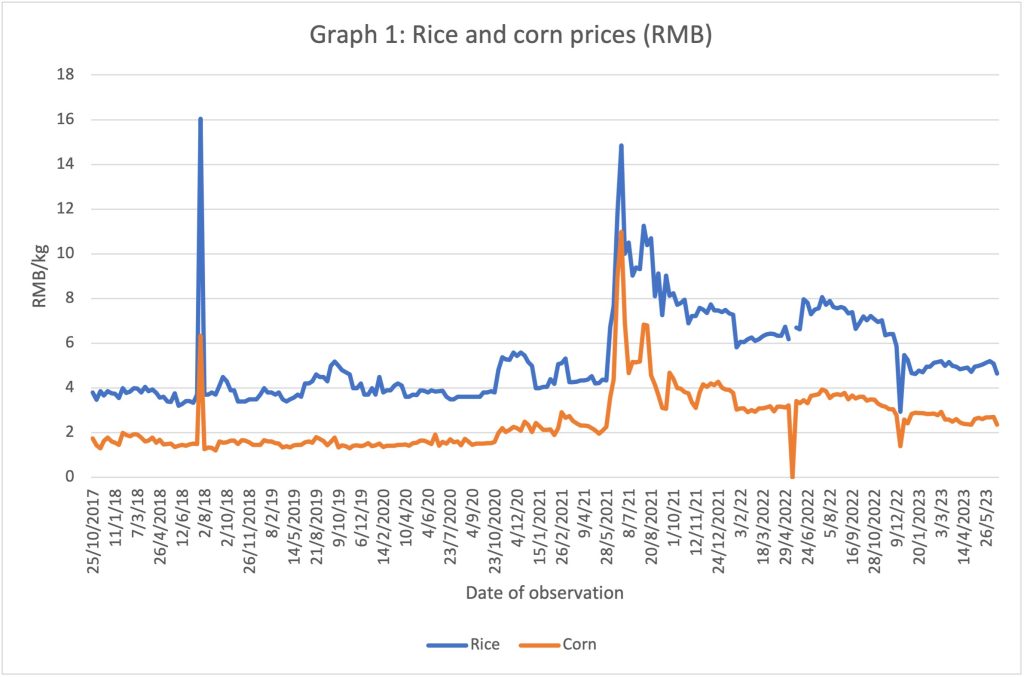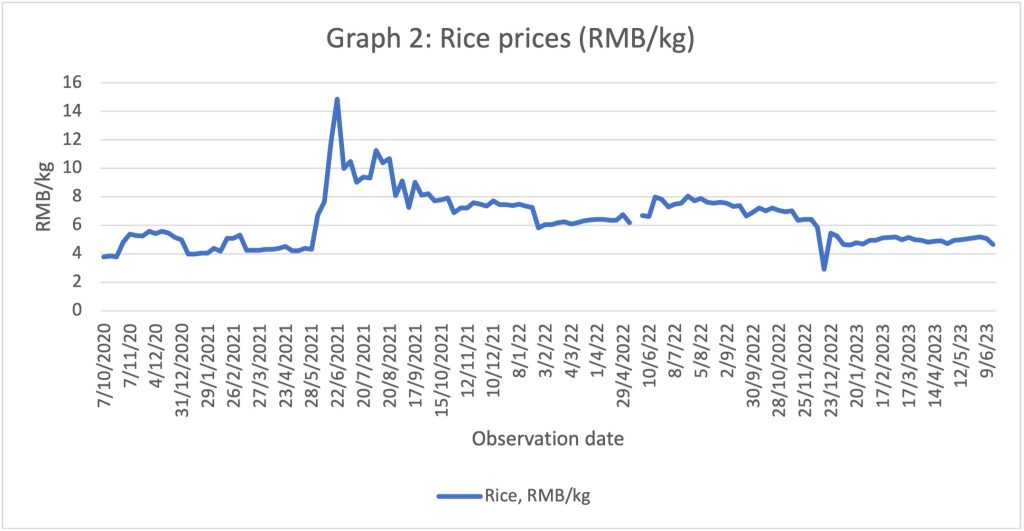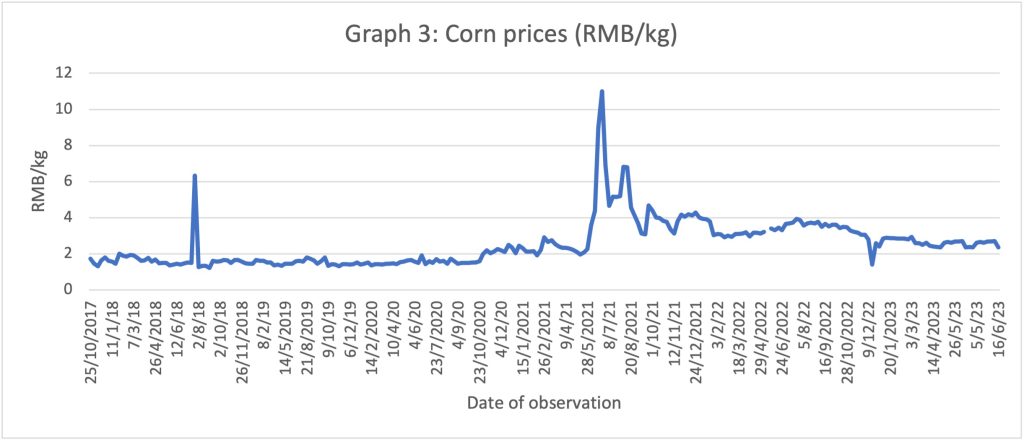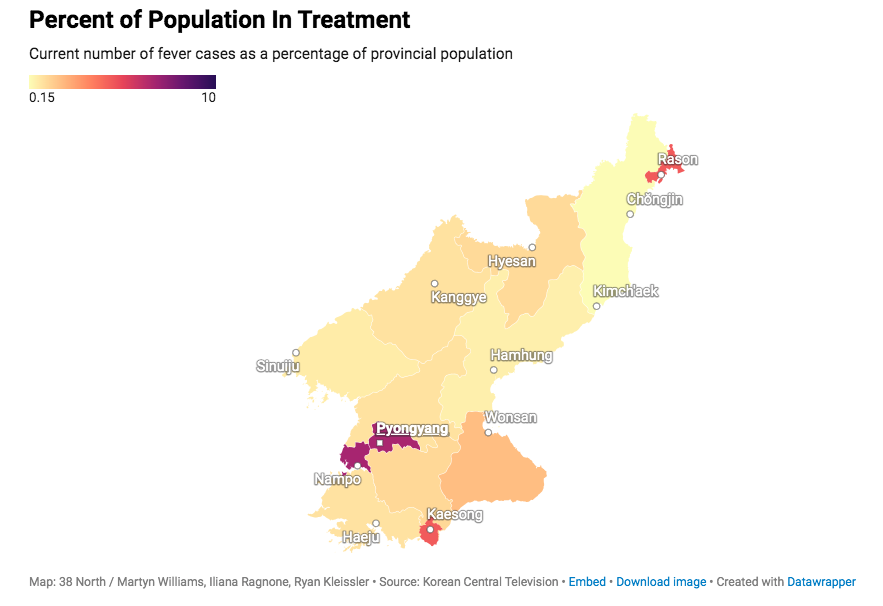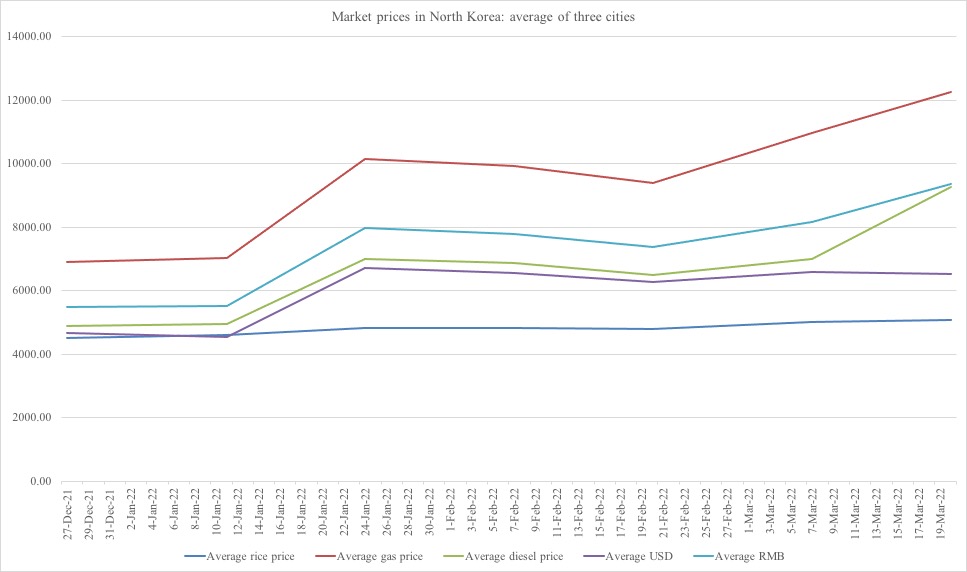By: Benjamin Katzeff Silberstein
As the South Korean government has said, this week’s meeting in Pyongyang on the food situation is as close to an open admission either of serious food shortages already prevailing, or that the regime forecasts that things will get worse. But what do we really know? In this post, I look at two main indicators: reports and testimonies from inside North Korea reported by the defector-run news outlet Daily NK, and market prices, primarily of corn and rice.
Overall, the food situation appears significantly more difficult than usual. Increased corn prices is perhaps the most worrying indicator. Comparisons with the famine of the 1990s still aren’t warranted, but there are worrying signs that the state wants to tighten control over agricultural production. At the same time, some of the policies put forward by the government make relative sense, in particular those reported by Daily NK (and have not been confirmed by the government). In conclusion, the situation appears concerning and could reasonably be called a “crisis”, but it still does not appear to be in disaster territory. This could change quickly depending on weather conditions and government policies, particularly on border trade.
A note of caution
It’s important to bear in mind that the North Korean regime carefully plans what messages it wants to send to the outside world. It’s not always clear exactly what that message is, but it does exist. The government has a purpose in holding a public meeting of this sort, and in telling the world about it. That’s not saying the regime is being dishonest about the situation, but they do have a clear incentive to let China first and foremost, but also the international community at large, know that they need food assistance. It could also be directed towards the broader international community, and there have been reports that the government has been in talks with UN organs about food aid.
The food situation and Covid-19
North Korea’s food situation has made a peculiar and sad journey over the past few years. During Kim Jong-un’s first few years in power, agricultural production increased for the most part, a pattern that began already under Kim Jong-il. The food situation overall continued to seem stabile, for the most part, throughout the “maximum pressure” and negotiations of sanctions in 2017–2019. Things really became problematic when North Korea shut its borders to foreign trade in the winter of 2020 to stave off Covid-19. Although North Korea doesn’t (openly) import much food, its agricultural system relies on imports of fertilizer and some agricultural equipment, and spare parts for tractors and machines.
The border closure also significantly disrupted the flow of information from the country. Because of the government’s strict enforcement of border controls, it has become significantly more dangerous and difficult for independent organizations (mostly based in South Korea) with sources inside the country to keep in regular contact, and traders and smugglers cannot venture over to China in the same way they normally have since the early 2000s. North Korea has always been a closed society, but this is even more true since the beginning of the pandemic.
What does the state say?
To understand how the North Korean government sees the agricultural situation, it’s worth looking in-depth at the summary report published by Rodong Sinmun today (March 2nd, 2023). The current spotlight on agriculture is really part of a longer focus that began in 2021, and isn’t as sudden as the global interest in it (my emphasis throughout the text):
The plenary meeting of the WPK Central Committee had a discussion of historic significance to comprehensively analyze and review the work for 2022, the first year of implementing the programme for the rural revolution in the new era, and further concretize the important tasks and long-term objectives for putting the agricultural production on a stable and sustained growth track and the urgent tasks arising at the present stage of the national economic development and the practical ways for carrying them out.
North Korean parlance has a way of making every issue “the most important”, but it’s very clear that agriculture is explicitly front and center on the economic policy agenda:
The concluding speech raised again the revolutionary change of the rural communities at the present stage of struggle as an important revolutionary task for achieving the prosperity and development of the state and the promotion of the people’s well-being, and put forward the principled matters to be maintained in implementing the programme for the socialist rural revolution in a perfect way.
It referred to the intention of the Party Central Committee which set the attainment of the grain production goal as the first target of the 12 major goals for the national economic development and the main purpose of the current enlarged plenary meeting, and raised the main goals and tasks for agricultural development.
The problem is, of course, what to do in practice. The report is short on specifics and concrete details, and most statements related to policy appear to advocate modernization for the sake of it, but with what resources? Highlighting the role of irrigation and mechanization suggests the government does have a sense of the most central challenges on the ground, but to develop these areas, North Korea would need to import both machinery and spare parts:
It is necessary to set it as a priority task in ensuring the stable development of agriculture at present to accelerate the completion of the overall irrigation system to cope with abnormal climatic phenomena, and dynamically push ahead with the irrigation project planned for this year and perfect the irrigation system of the country in the period of the five-year plan.
The machine-building industry and agricultural sectors should produce and supply to the rural communities more new and high-efficient farm machines which are the most necessary and effective in putting the agricultural production on a modern and advanced basis, while steadily propelling the work for renovating the farm machine sector in an innovative way.
From a policy perspective, the emphasis on the role of the state is worrying. In other policy areas, North Korean rhetoric over the past few years has been clear that the state seeks to take back control over the direction of the economy from markets and other non-government players. Further centralizing state control over agriculture could be devastating for efficiency, but I’m not sure this section of the report must be read that way. Rather, it could be about local government organs supporting farmers with what they need (again, unclear with what money):
In order to increase the nationwide agricultural output, attention should be paid to overcoming the lopsidedness in the guidance on farming and keeping the balance to be responsible for farming as a whole and it is important to concentrate on increasing the per-hectare yield at all the farms. This is an important principle for guidance on the agricultural production.
The General Secretary stressed the need to enhance the role of the provincial, city and county guidance organs and all the farms in attaining the long-term objectives of agricultural development.
[…]
The concluding speech put forward the measures for further expanding the rural construction this year and the policy-oriented tasks to be prioritized and pushed forward with by cities and counties.
In order to attain the gigantic long-term objectives of rural development, it is necessary to decisively strengthen the Party guidance over the agricultural sector and improve the rural Party work.
[…]
He stressed the need for all Party organizations to intensify the struggle against the practices of weakening the organizational and executive power of the Cabinet, the economic headquarters of the country, and thoroughly orient and subordinate the Party work to the implementation of the Party’s policies, thus getting their working efficiency verified in the practical struggle for attaining the 12 major goals for the development of the national economy this year.
Reports from independent sources
A few recent articles from Daily NK (henceforth DNK) shine interesting light on the situation. Their reporting gives the impression of a protracted, difficult situation rather than a sudden emergency. DNK reports, for example, that the North Korean currency has strengthened against foreign currencies with expectations that trade may soon begin again:
Because hopes of expanded trade have been frustrated several times before, North Koreans are not rushing out to secure foreign exchange even when the government hands down orders regarding the expansion of trade.
According to Daily NK’s recent survey of North Korean currency rates and market prices, the US dollar was trading at KPW 8,400 in Sinuiju, North Pyongan Province as of Feb. 19.
As that figure represents a mere 0.2% increase from the previous survey on Feb. 5, when the dollar was trading at KPW 8,380, the rate does not appear to have changed significantly.
In Pyongyang as well, the dollar was trading at KPW 8,360, more or less what it was on Feb. 5, when it was trading at KPW 8,370.
[…]
With rising expectations of reopened trade repeatedly dashed over the last three years, trade-related directives from the North Korean authorities are not immediately translating into renewed trade, a reporting partner in North Hamgyong Province told Daily NK recently, speaking on condition of anonymity.
In fact, North Korean authorities issued orders on Feb. 10 to provincial trading agencies calling for submissions of general plans for import and export activities and foreign currency acquisition.
The reporting partner said trade has failed to restart several times during the COVID period even after the authorities said it would.
“As long as the government issues no clear permissions [to resume] trade, orders to merely prepare [to restart trade] are not leading people to buy yuan,” he said.
DNK also reports that the steep, recent climb in food prices may have been generated by signals from the state that its food reserves increasingly need to be replenished. These price hikes are very significant, and far larger than normal:
North Korean market rice prices have recently skyrocketed after holding steady since last November’s harvest. A nationwide campaign of soliciting donations of “patriotic rice” may have helped fuel the dramatic rise in market rice prices.
According to Daily NK’s regular survey of market prices in North Korea, a kilogram of rice in Pyongyang’s markets cost KPW 6,000 as of Feb. 19. On Feb. 5, it cost just KPW 5,200, meaning the price climbed 15% in just two weeks.
Thus, the price of rice in Pyongyang climbed about KPW 6,000 for the first time in three months, having held steady in the KPW 5,000 to 6,000 range since last November.
The price of rice climbed in other regions, too. The price of rice in Sinuiju and Hyesan climbed 9% and 5%, respectively, between Feb. 5 and Feb. 19.
[…]
The recent spike in North Korean rice prices is smaller than the climb immediately following the border closure; however, the spike is much steeper that the usual increase in prices early in the new year.
On the other hand, the price of corn in North Korean markets has trended differently from region to region.
A kilogram of corn cost KPW 2,700 in Pyongyang as of Feb. 19, 6% less than it did on Feb. 5, when it cost KWP 2,900.
This means that while demand for rice has increased in Pyongyang, demand for corn has fallen.
In Sinuiju, a kilogram of corn cost KPW 3,000 as of Feb. 19, the same as it did earlier in the month. On the other hand, in Hyesan, the price of corn has climbed. A kilogram of corn in Hyesan’s markets cost KPW 3,300 as of Feb. 19, 6% more than it did on Feb. 5, when it cost just KPW 3,100. In Hyesan, the price of rice and corn both rose 5 to 6%.
The state is both supporting market prices more through grain distribution, but also demanding more from the people. This means that while prices have been kept somewhat stable by the state opening its storage houses for some public distribution during the winter, the state is signaling shortages by demanding more rice from the public:
The recent climb in market rice prices appears influenced by the country’s nationwide campaign for “patriotic rice” contributions and insufficient supplies at official grain shops.
Daily NK recently reported through a source in North Hamgyong Province that North Korea is asking all citizens to contribute at least 5 kilograms of “patriotic rice.”
There are price differences region to region, but since rice generally costs twice as much as corn, the North Korean government is treating 10 kilograms of corn as equal to five kilograms of rice when accepting donations. In fact, many North Koreans are donating whichever grain is cheaper in their areas of residence. As a result, rice prices have spiked sharply in Pyongyang and Sinuiju, where rice had been relatively cheap compared to corn.
Moreover, entering February, state-run food shops have sold only small amounts grain to consumers, which appears to have helped contribute to the spike in market grain prices.
Thanks to DNK, we also have some sense of at least what some North Koreans have been told about the plenary meeting on agricultural issues. Interestingly, the policies mentioned appear much more prudent and wise than those included in the Rodong Sinmun report:
In particular, North Korea’s government ordered each province to secure irrigation facilities appropriate for their geographic conditions and draw up plans to ensure water for terraced fields, calling irrigation facilities that work no matter what the climatic conditions “the most important issue.”
North Korea’s leadership also ordered the preparation of various data, including soil analyses of farmland, analyses of irrigation conditions and analyses of progress in agricultural mechanization.
[…]
The province’s authorities also ordered the writing of a draft plan for scientific farming in accordance with soil and lot conditions, and called on officials to hurry construction of modern agricultural housing as per this year’s plans, the source said.
How far these measures can go is very hard to tell and, again, no major change will occur unless the state dedicates significant resources to agricultural development. That would mean moving resources from higher-priority areas, which the state is unlikely to do in the near future.
